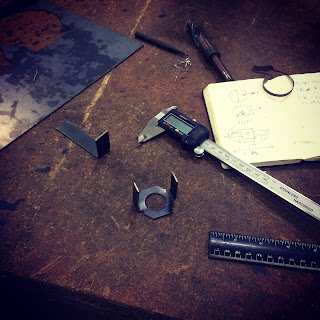My last rotational valving prototype showed some promise, so I decided to try a modification, with a third sheath that had a linear set of openings, so that there would be three layers:
These fit together Russian-nesting-doll style. There's about a 1" gap between the inner and the middle, so the flame will stay alight, and the inner and outer have only about 1/16" between them, to act as the gate. I also spent some time making a nice bracket for holding the inner pipe in place without requiring bolts, so that the outer pipe could be flush with the inner pipe. It slides inside the middle pipe and was welded in place. Required me to resurrect some sheet metal working skills.
The results of the test were, well, not good:
You do again see some modulation of the flame, but it's a small effect. My impression is that the double-gating is making it such that no air is reaching the actual gas outlet at the inner tube, and we're only getting ignition as the gas escapes into the "atmosphere." One problem with building smaller-scale prototypes and scaling them up is that you see these kinds of problems: air flow and gas flow is much worse. I considered running an air line into the inner tube, and pumping air into it. That said, I'm not certain that this design is a good idea overall, and I'm going to take a break from it. The machining is fun, but it's not proving very useful.
I have some work to do on trying to improve the multiplexing prototype, but I'm less bullish on that at the moment as well given the problems. I've been avoiding this for a while, but I think a much simpler concept might give me a much better aesthetic impression, which is basically just a small pipe that mechanically runs back and forth inside a larger pipe, like a shuttle, carrying a tube along with it, and simply carrying the flame, physically, that way:
I want to use Viton tubing to carry the gas to the shuttle, it's good to 400F, and it's resistant to propane. But fire art safety might disagree; they seem pretty set on the idea that you can only use manufactured LP hose. I don't think it's impossible, with a 4" diameter tube, to use manufactured hose. It might be a future discussion if this design turns out to be good. Having spent a lot of time working on this, I'm feeling more confident in my thoughts about safety and maybe straying outside the bounds of what is specifically published. Including something like an excess flow check valve might help, though it might also be prohibitively expensive.
Leaving for the burn on Monday. No more fire art for this week probably, except for running around with my backpack on. Come find me at Playasos at 8:45 and B if you're there, and say hi.
The results of the test were, well, not good:
You do again see some modulation of the flame, but it's a small effect. My impression is that the double-gating is making it such that no air is reaching the actual gas outlet at the inner tube, and we're only getting ignition as the gas escapes into the "atmosphere." One problem with building smaller-scale prototypes and scaling them up is that you see these kinds of problems: air flow and gas flow is much worse. I considered running an air line into the inner tube, and pumping air into it. That said, I'm not certain that this design is a good idea overall, and I'm going to take a break from it. The machining is fun, but it's not proving very useful.
I have some work to do on trying to improve the multiplexing prototype, but I'm less bullish on that at the moment as well given the problems. I've been avoiding this for a while, but I think a much simpler concept might give me a much better aesthetic impression, which is basically just a small pipe that mechanically runs back and forth inside a larger pipe, like a shuttle, carrying a tube along with it, and simply carrying the flame, physically, that way:
Leaving for the burn on Monday. No more fire art for this week probably, except for running around with my backpack on. Come find me at Playasos at 8:45 and B if you're there, and say hi.


No comments:
Post a Comment